Accounting Theory and Contemporary Issues: Legislation and Impact
VerifiedAdded on 2023/03/23
|9
|2106
|72
Essay
AI Summary
This essay explores accounting theory and its application to contemporary issues, particularly focusing on the government's concern regarding the lack of corporate disclosure on social and environmental impacts. It examines the public interest theory, capture theory, and economic interest group perspective in relation to proposed legislation requiring corporations to disclose information about their social and environmental impacts and initiatives. The essay also discusses the types of constituents that would benefit from such legislation and how it would increase corporate accountability, even at the potential expense of financial success for heavily polluting organizations. Furthermore, it delves into the concept of accountability in relation to corporate performance, emphasizing the importance of transparency and ethical behavior within business organizations. This document is available on Desklib, a platform offering a range of study tools for students.
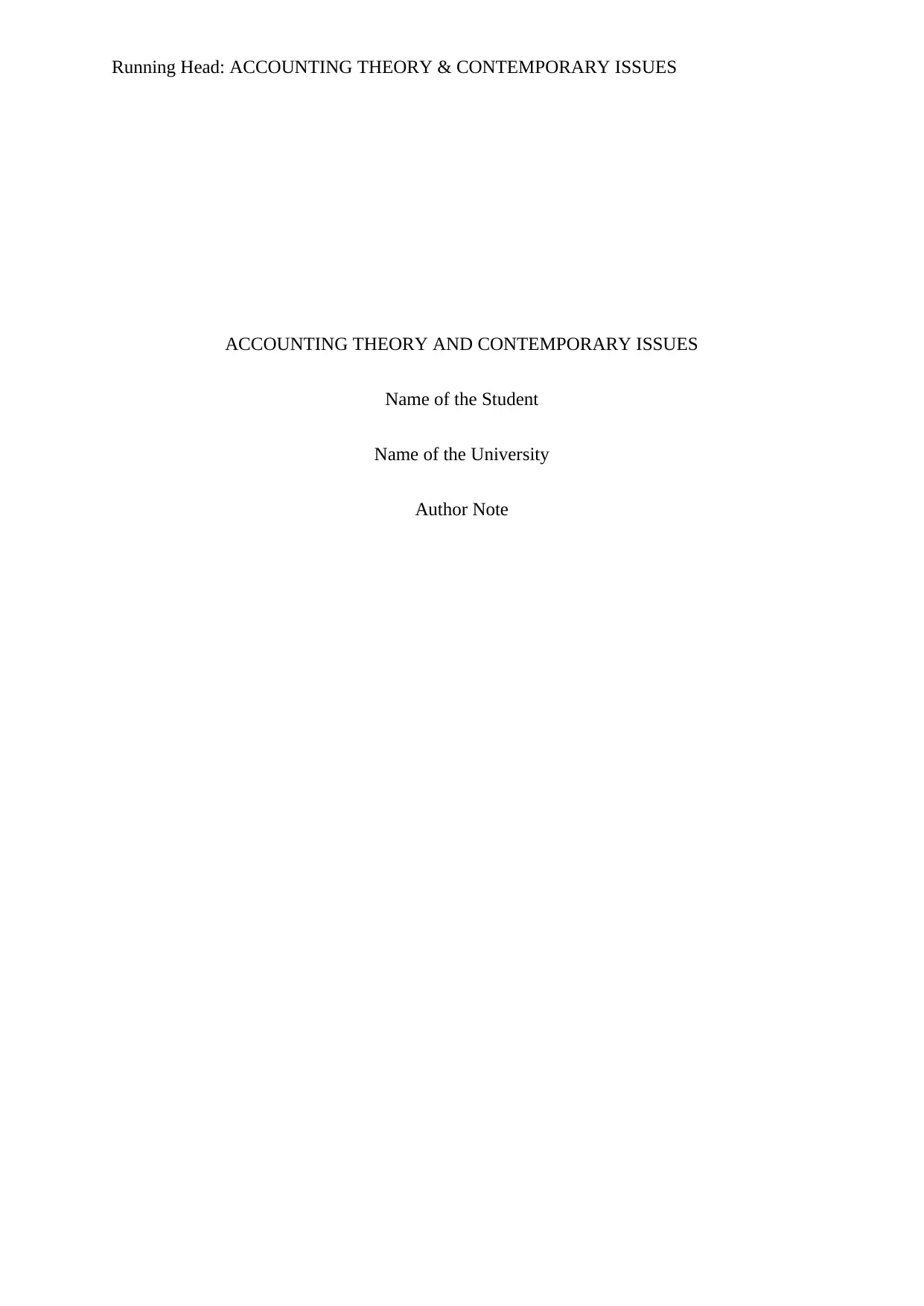
Running Head: ACCOUNTING THEORY & CONTEMPORARY ISSUES
ACCOUNTING THEORY AND CONTEMPORARY ISSUES
Name of the Student
Name of the University
Author Note
ACCOUNTING THEORY AND CONTEMPORARY ISSUES
Name of the Student
Name of the University
Author Note
Paraphrase This Document
Need a fresh take? Get an instant paraphrase of this document with our AI Paraphraser
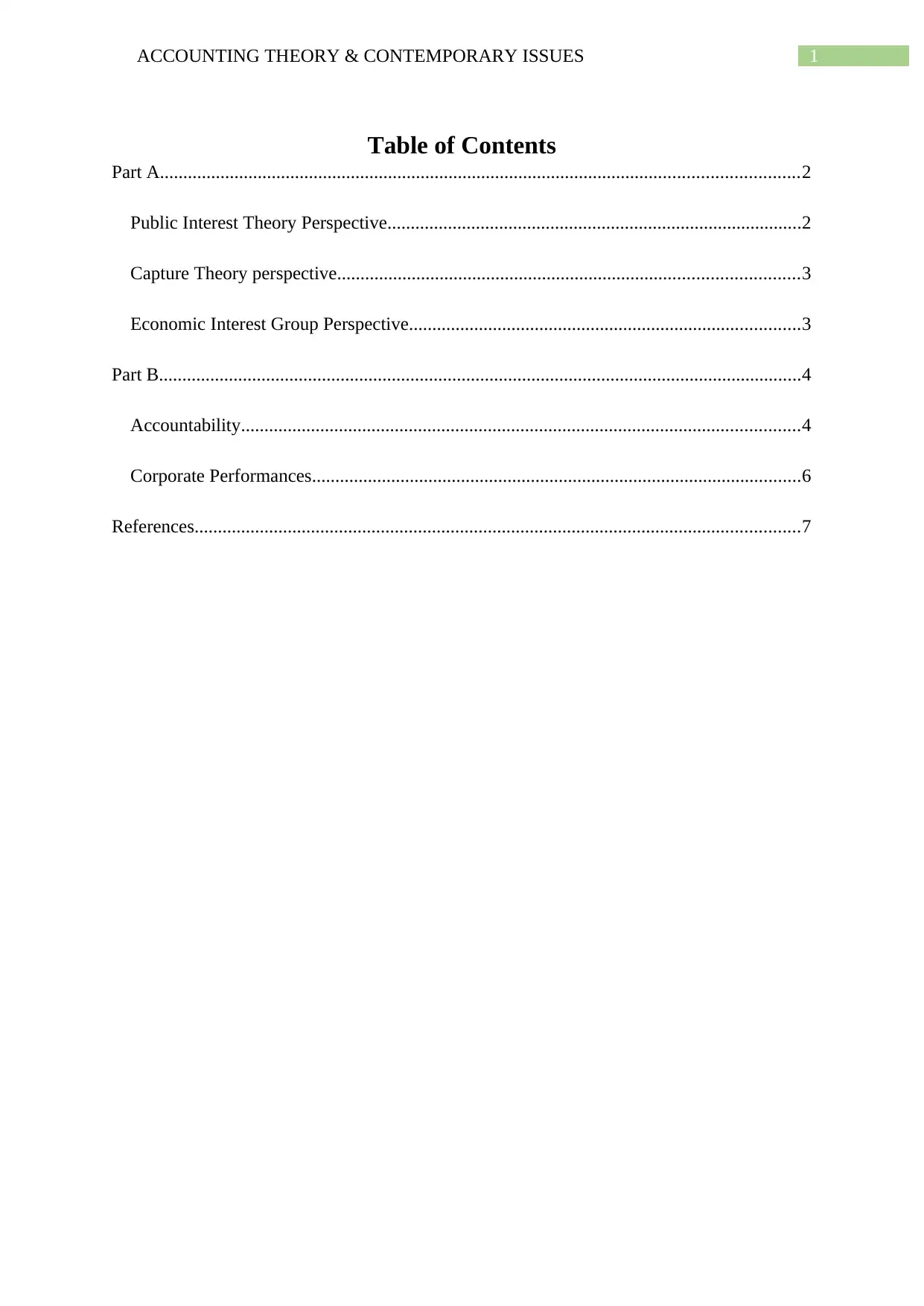
1ACCOUNTING THEORY & CONTEMPORARY ISSUES
Table of Contents
Part A.........................................................................................................................................2
Public Interest Theory Perspective.........................................................................................2
Capture Theory perspective...................................................................................................3
Economic Interest Group Perspective....................................................................................3
Part B..........................................................................................................................................4
Accountability........................................................................................................................4
Corporate Performances.........................................................................................................6
References..................................................................................................................................7
Table of Contents
Part A.........................................................................................................................................2
Public Interest Theory Perspective.........................................................................................2
Capture Theory perspective...................................................................................................3
Economic Interest Group Perspective....................................................................................3
Part B..........................................................................................................................................4
Accountability........................................................................................................................4
Corporate Performances.........................................................................................................6
References..................................................................................................................................7
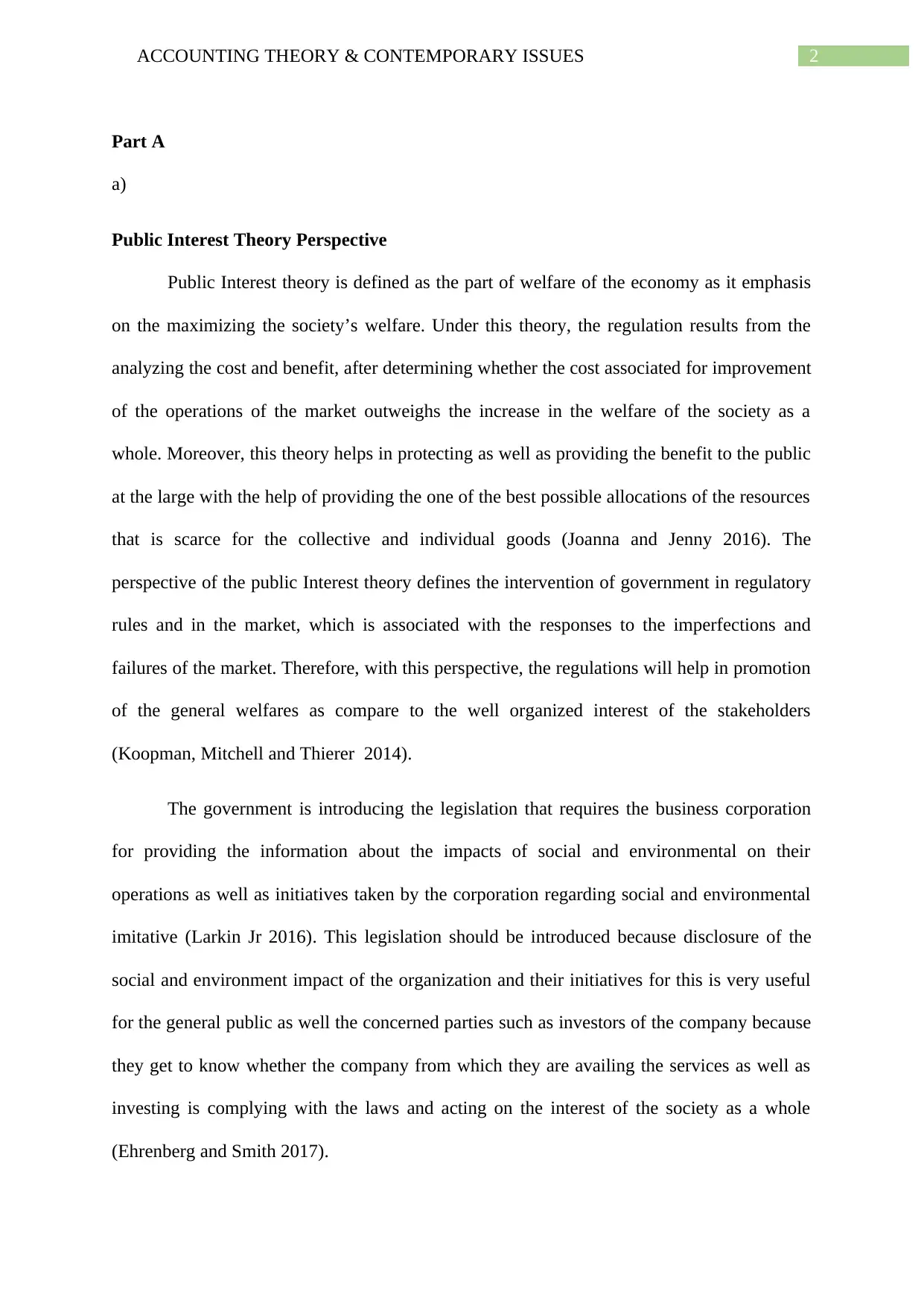
2ACCOUNTING THEORY & CONTEMPORARY ISSUES
Part A
a)
Public Interest Theory Perspective
Public Interest theory is defined as the part of welfare of the economy as it emphasis
on the maximizing the society’s welfare. Under this theory, the regulation results from the
analyzing the cost and benefit, after determining whether the cost associated for improvement
of the operations of the market outweighs the increase in the welfare of the society as a
whole. Moreover, this theory helps in protecting as well as providing the benefit to the public
at the large with the help of providing the one of the best possible allocations of the resources
that is scarce for the collective and individual goods (Joanna and Jenny 2016). The
perspective of the public Interest theory defines the intervention of government in regulatory
rules and in the market, which is associated with the responses to the imperfections and
failures of the market. Therefore, with this perspective, the regulations will help in promotion
of the general welfares as compare to the well organized interest of the stakeholders
(Koopman, Mitchell and Thierer 2014).
The government is introducing the legislation that requires the business corporation
for providing the information about the impacts of social and environmental on their
operations as well as initiatives taken by the corporation regarding social and environmental
imitative (Larkin Jr 2016). This legislation should be introduced because disclosure of the
social and environment impact of the organization and their initiatives for this is very useful
for the general public as well the concerned parties such as investors of the company because
they get to know whether the company from which they are availing the services as well as
investing is complying with the laws and acting on the interest of the society as a whole
(Ehrenberg and Smith 2017).
Part A
a)
Public Interest Theory Perspective
Public Interest theory is defined as the part of welfare of the economy as it emphasis
on the maximizing the society’s welfare. Under this theory, the regulation results from the
analyzing the cost and benefit, after determining whether the cost associated for improvement
of the operations of the market outweighs the increase in the welfare of the society as a
whole. Moreover, this theory helps in protecting as well as providing the benefit to the public
at the large with the help of providing the one of the best possible allocations of the resources
that is scarce for the collective and individual goods (Joanna and Jenny 2016). The
perspective of the public Interest theory defines the intervention of government in regulatory
rules and in the market, which is associated with the responses to the imperfections and
failures of the market. Therefore, with this perspective, the regulations will help in promotion
of the general welfares as compare to the well organized interest of the stakeholders
(Koopman, Mitchell and Thierer 2014).
The government is introducing the legislation that requires the business corporation
for providing the information about the impacts of social and environmental on their
operations as well as initiatives taken by the corporation regarding social and environmental
imitative (Larkin Jr 2016). This legislation should be introduced because disclosure of the
social and environment impact of the organization and their initiatives for this is very useful
for the general public as well the concerned parties such as investors of the company because
they get to know whether the company from which they are availing the services as well as
investing is complying with the laws and acting on the interest of the society as a whole
(Ehrenberg and Smith 2017).
⊘ This is a preview!⊘
Do you want full access?
Subscribe today to unlock all pages.

Trusted by 1+ million students worldwide
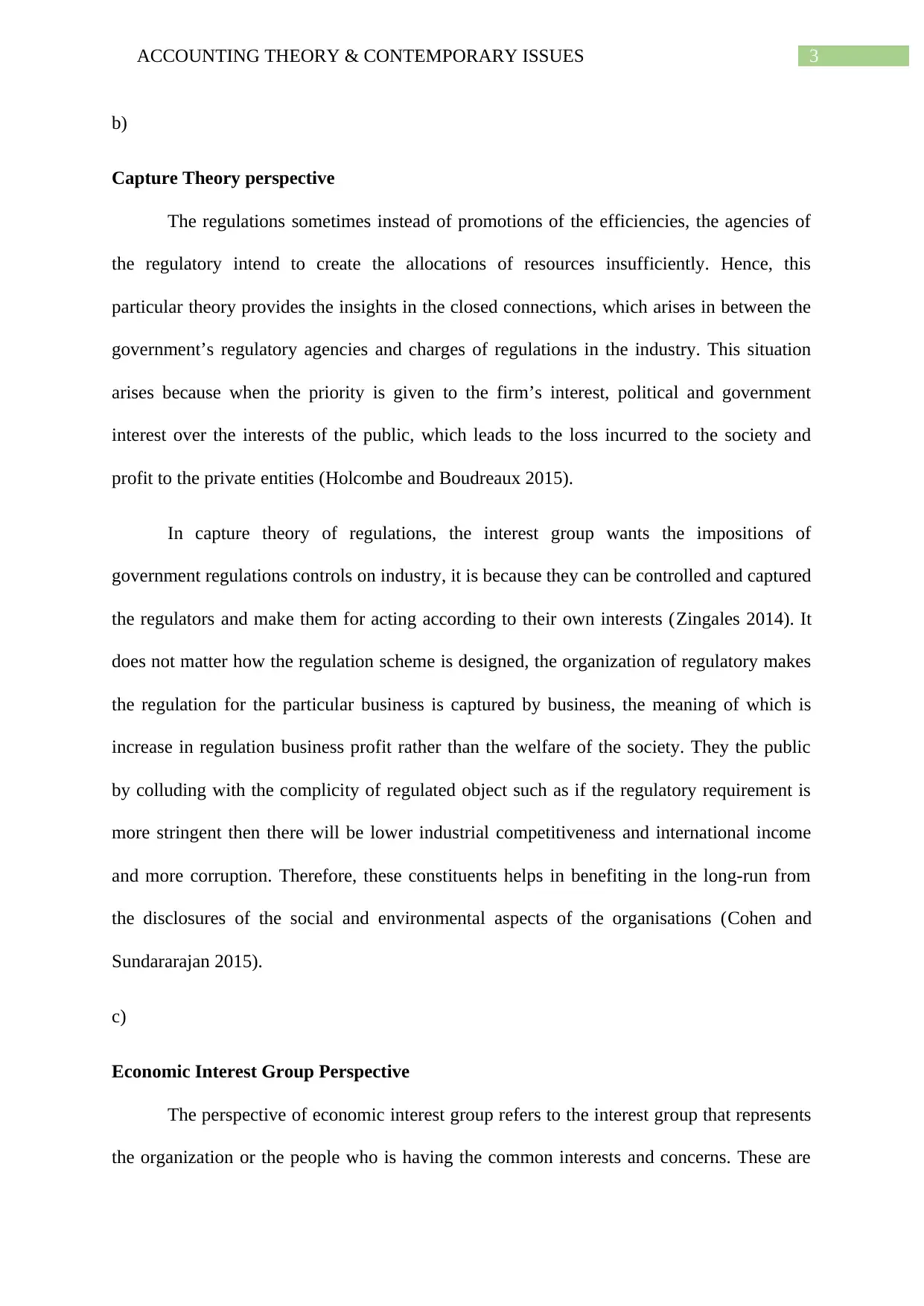
3ACCOUNTING THEORY & CONTEMPORARY ISSUES
b)
Capture Theory perspective
The regulations sometimes instead of promotions of the efficiencies, the agencies of
the regulatory intend to create the allocations of resources insufficiently. Hence, this
particular theory provides the insights in the closed connections, which arises in between the
government’s regulatory agencies and charges of regulations in the industry. This situation
arises because when the priority is given to the firm’s interest, political and government
interest over the interests of the public, which leads to the loss incurred to the society and
profit to the private entities (Holcombe and Boudreaux 2015).
In capture theory of regulations, the interest group wants the impositions of
government regulations controls on industry, it is because they can be controlled and captured
the regulators and make them for acting according to their own interests (Zingales 2014). It
does not matter how the regulation scheme is designed, the organization of regulatory makes
the regulation for the particular business is captured by business, the meaning of which is
increase in regulation business profit rather than the welfare of the society. They the public
by colluding with the complicity of regulated object such as if the regulatory requirement is
more stringent then there will be lower industrial competitiveness and international income
and more corruption. Therefore, these constituents helps in benefiting in the long-run from
the disclosures of the social and environmental aspects of the organisations (Cohen and
Sundararajan 2015).
c)
Economic Interest Group Perspective
The perspective of economic interest group refers to the interest group that represents
the organization or the people who is having the common interests and concerns. These are
b)
Capture Theory perspective
The regulations sometimes instead of promotions of the efficiencies, the agencies of
the regulatory intend to create the allocations of resources insufficiently. Hence, this
particular theory provides the insights in the closed connections, which arises in between the
government’s regulatory agencies and charges of regulations in the industry. This situation
arises because when the priority is given to the firm’s interest, political and government
interest over the interests of the public, which leads to the loss incurred to the society and
profit to the private entities (Holcombe and Boudreaux 2015).
In capture theory of regulations, the interest group wants the impositions of
government regulations controls on industry, it is because they can be controlled and captured
the regulators and make them for acting according to their own interests (Zingales 2014). It
does not matter how the regulation scheme is designed, the organization of regulatory makes
the regulation for the particular business is captured by business, the meaning of which is
increase in regulation business profit rather than the welfare of the society. They the public
by colluding with the complicity of regulated object such as if the regulatory requirement is
more stringent then there will be lower industrial competitiveness and international income
and more corruption. Therefore, these constituents helps in benefiting in the long-run from
the disclosures of the social and environmental aspects of the organisations (Cohen and
Sundararajan 2015).
c)
Economic Interest Group Perspective
The perspective of economic interest group refers to the interest group that represents
the organization or the people who is having the common interests and concerns. These are
Paraphrase This Document
Need a fresh take? Get an instant paraphrase of this document with our AI Paraphraser
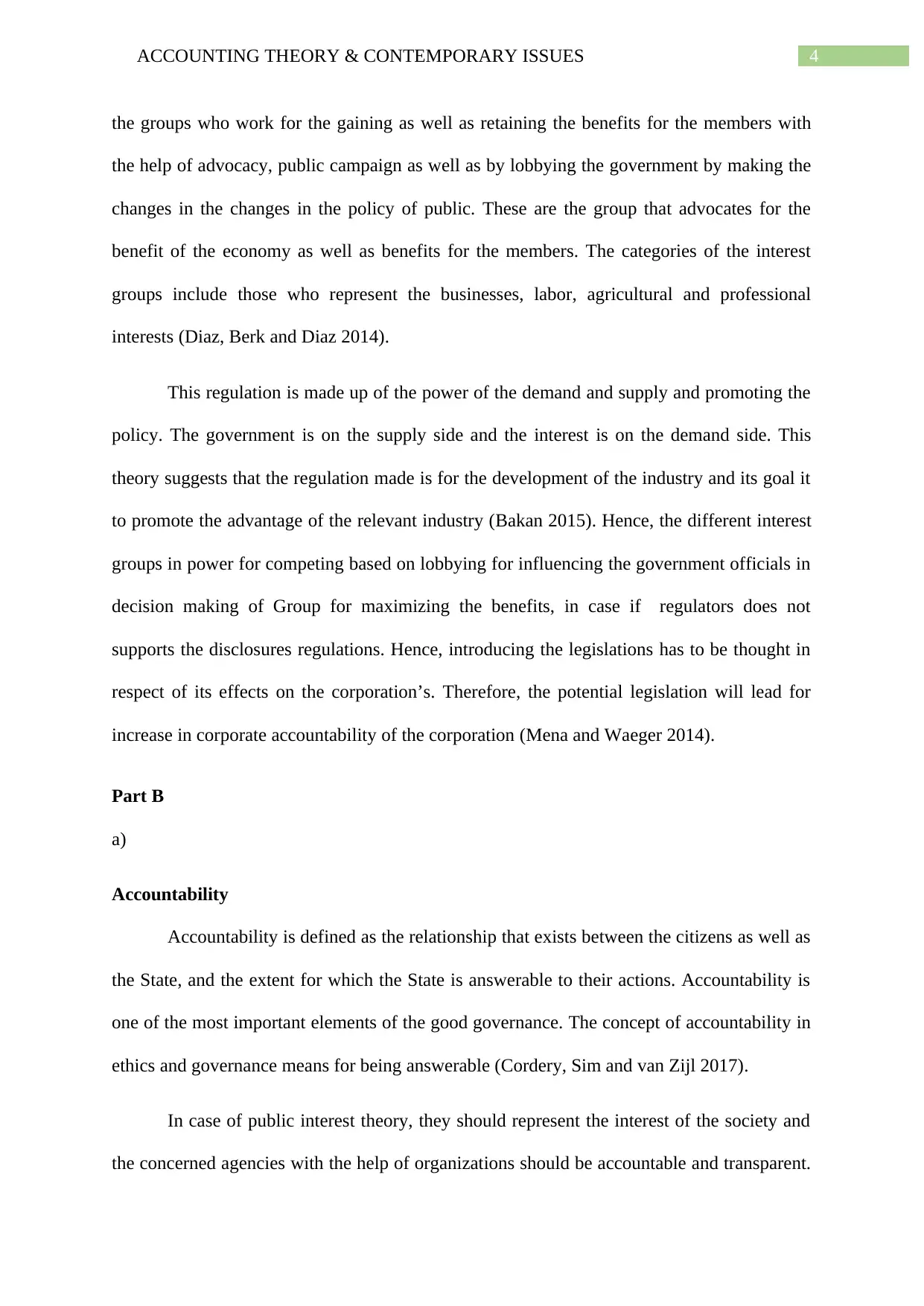
4ACCOUNTING THEORY & CONTEMPORARY ISSUES
the groups who work for the gaining as well as retaining the benefits for the members with
the help of advocacy, public campaign as well as by lobbying the government by making the
changes in the changes in the policy of public. These are the group that advocates for the
benefit of the economy as well as benefits for the members. The categories of the interest
groups include those who represent the businesses, labor, agricultural and professional
interests (Diaz, Berk and Diaz 2014).
This regulation is made up of the power of the demand and supply and promoting the
policy. The government is on the supply side and the interest is on the demand side. This
theory suggests that the regulation made is for the development of the industry and its goal it
to promote the advantage of the relevant industry (Bakan 2015). Hence, the different interest
groups in power for competing based on lobbying for influencing the government officials in
decision making of Group for maximizing the benefits, in case if regulators does not
supports the disclosures regulations. Hence, introducing the legislations has to be thought in
respect of its effects on the corporation’s. Therefore, the potential legislation will lead for
increase in corporate accountability of the corporation (Mena and Waeger 2014).
Part B
a)
Accountability
Accountability is defined as the relationship that exists between the citizens as well as
the State, and the extent for which the State is answerable to their actions. Accountability is
one of the most important elements of the good governance. The concept of accountability in
ethics and governance means for being answerable (Cordery, Sim and van Zijl 2017).
In case of public interest theory, they should represent the interest of the society and
the concerned agencies with the help of organizations should be accountable and transparent.
the groups who work for the gaining as well as retaining the benefits for the members with
the help of advocacy, public campaign as well as by lobbying the government by making the
changes in the changes in the policy of public. These are the group that advocates for the
benefit of the economy as well as benefits for the members. The categories of the interest
groups include those who represent the businesses, labor, agricultural and professional
interests (Diaz, Berk and Diaz 2014).
This regulation is made up of the power of the demand and supply and promoting the
policy. The government is on the supply side and the interest is on the demand side. This
theory suggests that the regulation made is for the development of the industry and its goal it
to promote the advantage of the relevant industry (Bakan 2015). Hence, the different interest
groups in power for competing based on lobbying for influencing the government officials in
decision making of Group for maximizing the benefits, in case if regulators does not
supports the disclosures regulations. Hence, introducing the legislations has to be thought in
respect of its effects on the corporation’s. Therefore, the potential legislation will lead for
increase in corporate accountability of the corporation (Mena and Waeger 2014).
Part B
a)
Accountability
Accountability is defined as the relationship that exists between the citizens as well as
the State, and the extent for which the State is answerable to their actions. Accountability is
one of the most important elements of the good governance. The concept of accountability in
ethics and governance means for being answerable (Cordery, Sim and van Zijl 2017).
In case of public interest theory, they should represent the interest of the society and
the concerned agencies with the help of organizations should be accountable and transparent.
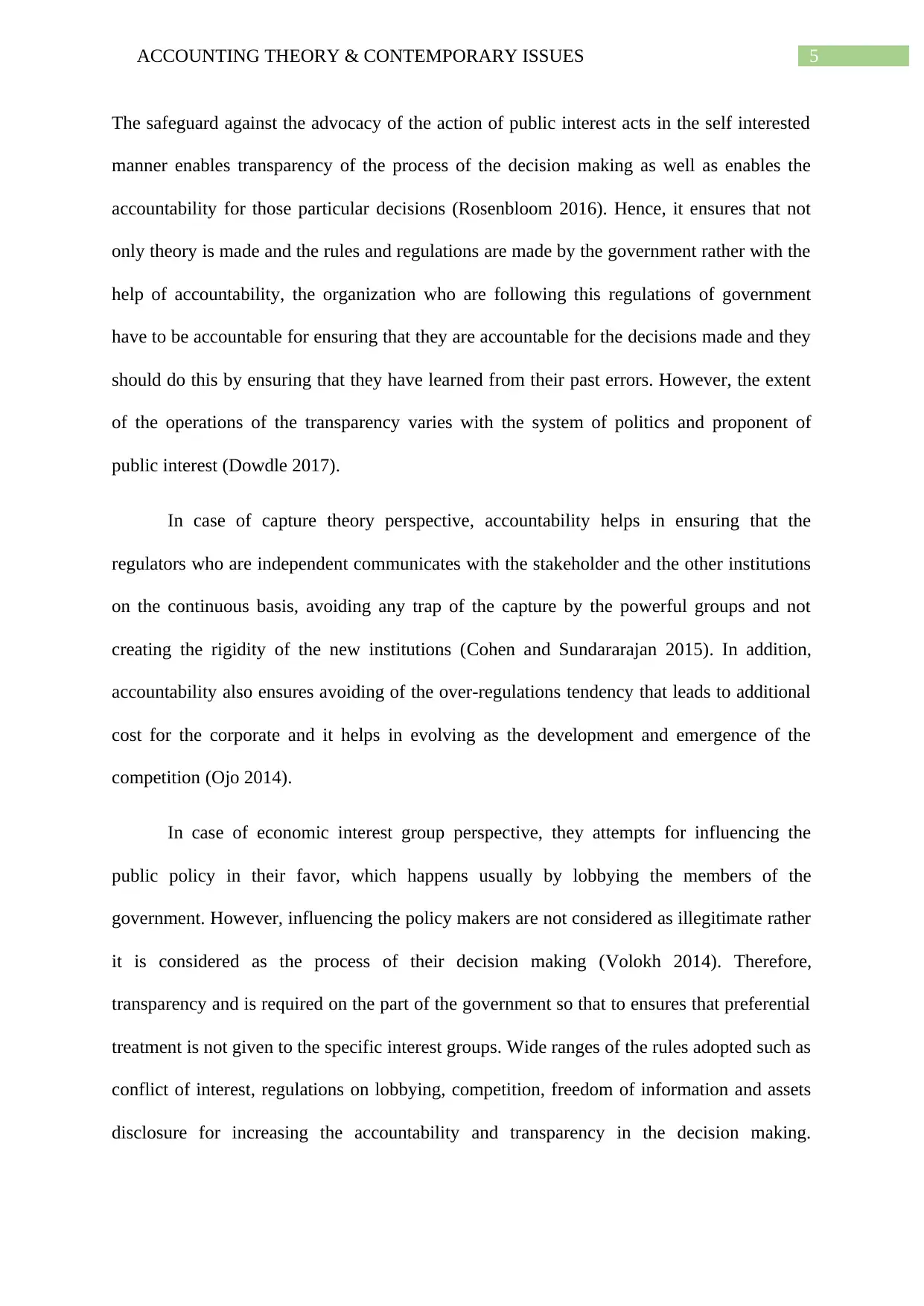
5ACCOUNTING THEORY & CONTEMPORARY ISSUES
The safeguard against the advocacy of the action of public interest acts in the self interested
manner enables transparency of the process of the decision making as well as enables the
accountability for those particular decisions (Rosenbloom 2016). Hence, it ensures that not
only theory is made and the rules and regulations are made by the government rather with the
help of accountability, the organization who are following this regulations of government
have to be accountable for ensuring that they are accountable for the decisions made and they
should do this by ensuring that they have learned from their past errors. However, the extent
of the operations of the transparency varies with the system of politics and proponent of
public interest (Dowdle 2017).
In case of capture theory perspective, accountability helps in ensuring that the
regulators who are independent communicates with the stakeholder and the other institutions
on the continuous basis, avoiding any trap of the capture by the powerful groups and not
creating the rigidity of the new institutions (Cohen and Sundararajan 2015). In addition,
accountability also ensures avoiding of the over-regulations tendency that leads to additional
cost for the corporate and it helps in evolving as the development and emergence of the
competition (Ojo 2014).
In case of economic interest group perspective, they attempts for influencing the
public policy in their favor, which happens usually by lobbying the members of the
government. However, influencing the policy makers are not considered as illegitimate rather
it is considered as the process of their decision making (Volokh 2014). Therefore,
transparency and is required on the part of the government so that to ensures that preferential
treatment is not given to the specific interest groups. Wide ranges of the rules adopted such as
conflict of interest, regulations on lobbying, competition, freedom of information and assets
disclosure for increasing the accountability and transparency in the decision making.
The safeguard against the advocacy of the action of public interest acts in the self interested
manner enables transparency of the process of the decision making as well as enables the
accountability for those particular decisions (Rosenbloom 2016). Hence, it ensures that not
only theory is made and the rules and regulations are made by the government rather with the
help of accountability, the organization who are following this regulations of government
have to be accountable for ensuring that they are accountable for the decisions made and they
should do this by ensuring that they have learned from their past errors. However, the extent
of the operations of the transparency varies with the system of politics and proponent of
public interest (Dowdle 2017).
In case of capture theory perspective, accountability helps in ensuring that the
regulators who are independent communicates with the stakeholder and the other institutions
on the continuous basis, avoiding any trap of the capture by the powerful groups and not
creating the rigidity of the new institutions (Cohen and Sundararajan 2015). In addition,
accountability also ensures avoiding of the over-regulations tendency that leads to additional
cost for the corporate and it helps in evolving as the development and emergence of the
competition (Ojo 2014).
In case of economic interest group perspective, they attempts for influencing the
public policy in their favor, which happens usually by lobbying the members of the
government. However, influencing the policy makers are not considered as illegitimate rather
it is considered as the process of their decision making (Volokh 2014). Therefore,
transparency and is required on the part of the government so that to ensures that preferential
treatment is not given to the specific interest groups. Wide ranges of the rules adopted such as
conflict of interest, regulations on lobbying, competition, freedom of information and assets
disclosure for increasing the accountability and transparency in the decision making.
⊘ This is a preview!⊘
Do you want full access?
Subscribe today to unlock all pages.

Trusted by 1+ million students worldwide
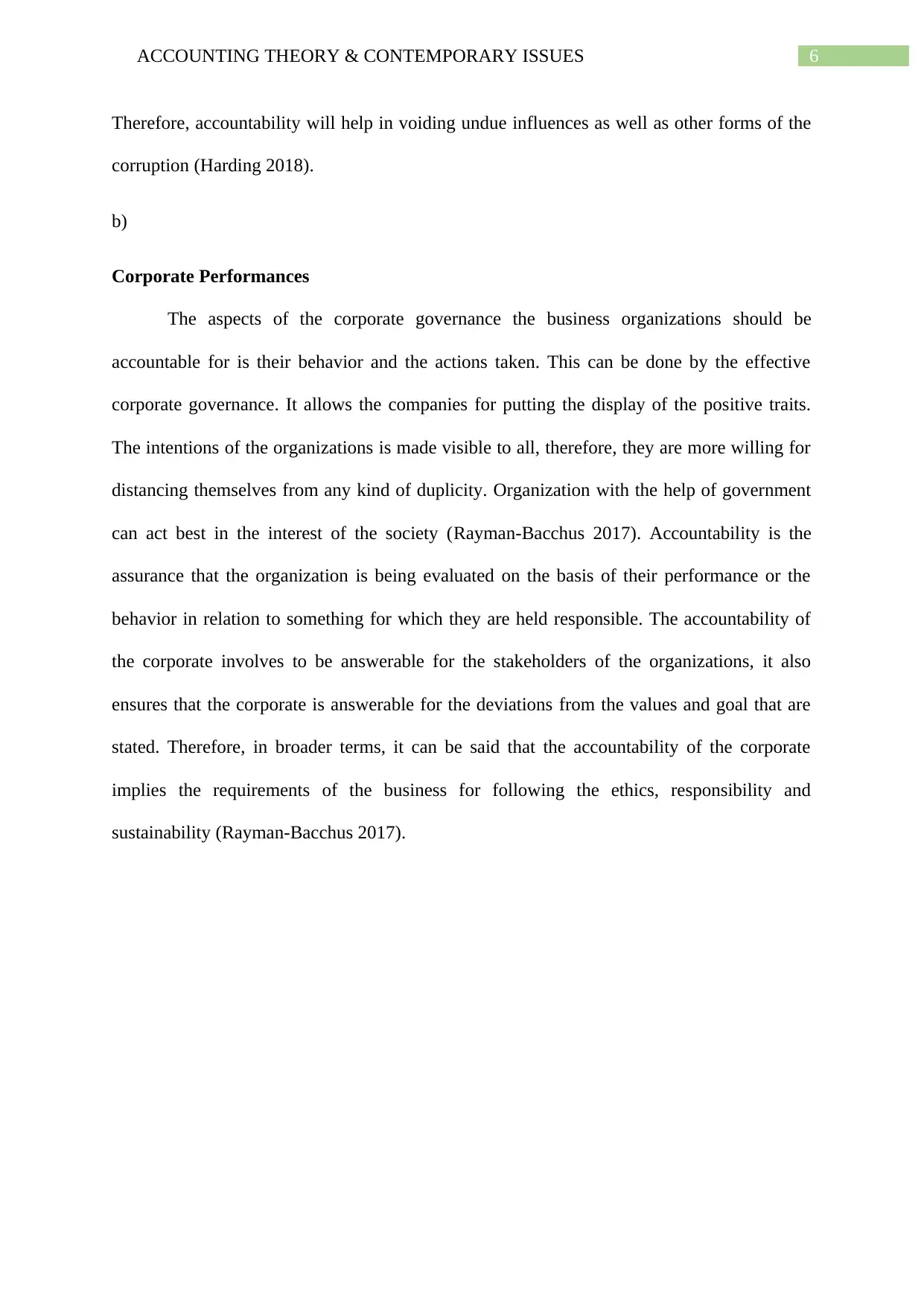
6ACCOUNTING THEORY & CONTEMPORARY ISSUES
Therefore, accountability will help in voiding undue influences as well as other forms of the
corruption (Harding 2018).
b)
Corporate Performances
The aspects of the corporate governance the business organizations should be
accountable for is their behavior and the actions taken. This can be done by the effective
corporate governance. It allows the companies for putting the display of the positive traits.
The intentions of the organizations is made visible to all, therefore, they are more willing for
distancing themselves from any kind of duplicity. Organization with the help of government
can act best in the interest of the society (Rayman-Bacchus 2017). Accountability is the
assurance that the organization is being evaluated on the basis of their performance or the
behavior in relation to something for which they are held responsible. The accountability of
the corporate involves to be answerable for the stakeholders of the organizations, it also
ensures that the corporate is answerable for the deviations from the values and goal that are
stated. Therefore, in broader terms, it can be said that the accountability of the corporate
implies the requirements of the business for following the ethics, responsibility and
sustainability (Rayman-Bacchus 2017).
Therefore, accountability will help in voiding undue influences as well as other forms of the
corruption (Harding 2018).
b)
Corporate Performances
The aspects of the corporate governance the business organizations should be
accountable for is their behavior and the actions taken. This can be done by the effective
corporate governance. It allows the companies for putting the display of the positive traits.
The intentions of the organizations is made visible to all, therefore, they are more willing for
distancing themselves from any kind of duplicity. Organization with the help of government
can act best in the interest of the society (Rayman-Bacchus 2017). Accountability is the
assurance that the organization is being evaluated on the basis of their performance or the
behavior in relation to something for which they are held responsible. The accountability of
the corporate involves to be answerable for the stakeholders of the organizations, it also
ensures that the corporate is answerable for the deviations from the values and goal that are
stated. Therefore, in broader terms, it can be said that the accountability of the corporate
implies the requirements of the business for following the ethics, responsibility and
sustainability (Rayman-Bacchus 2017).
Paraphrase This Document
Need a fresh take? Get an instant paraphrase of this document with our AI Paraphraser
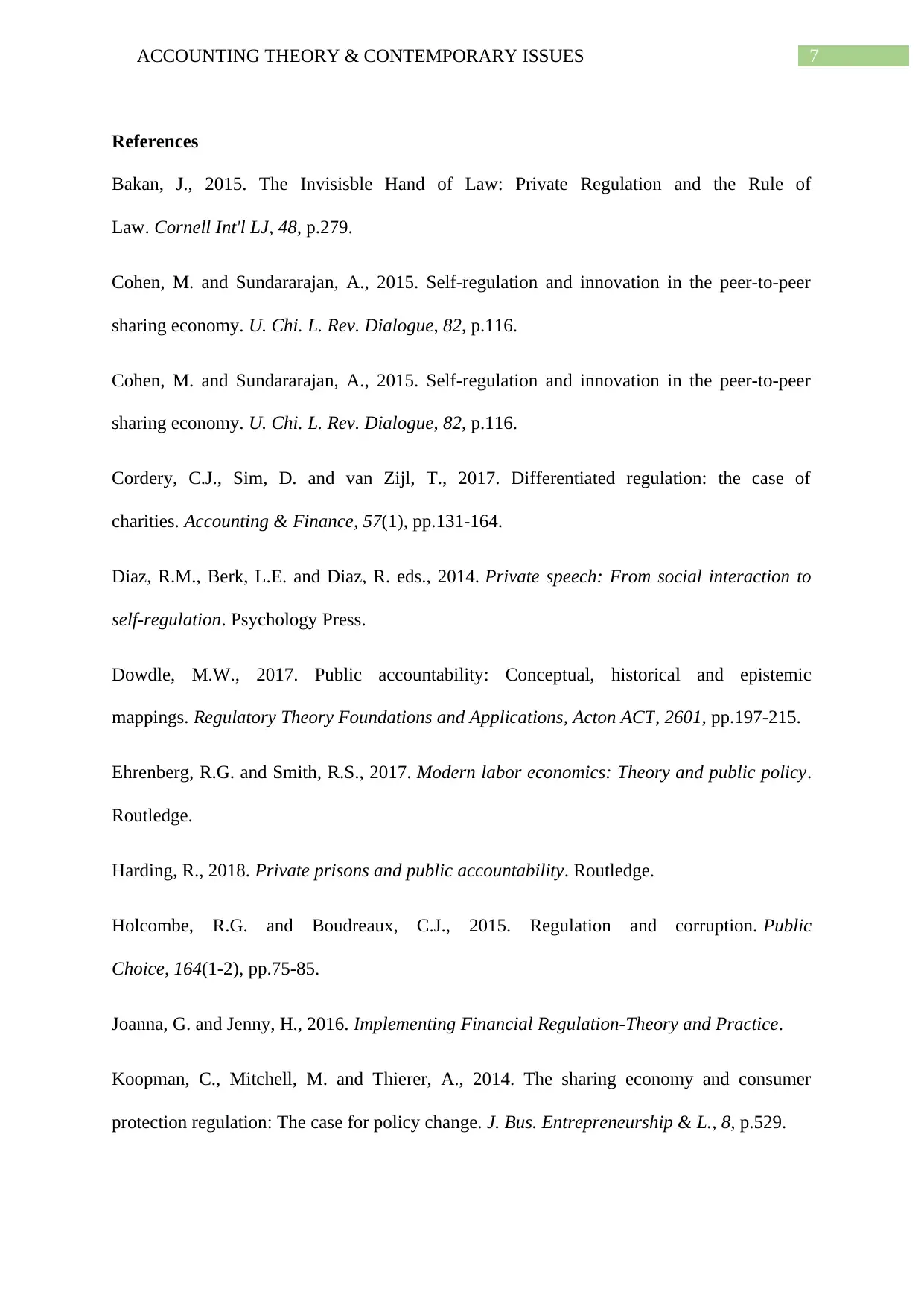
7ACCOUNTING THEORY & CONTEMPORARY ISSUES
References
Bakan, J., 2015. The Invisisble Hand of Law: Private Regulation and the Rule of
Law. Cornell Int'l LJ, 48, p.279.
Cohen, M. and Sundararajan, A., 2015. Self-regulation and innovation in the peer-to-peer
sharing economy. U. Chi. L. Rev. Dialogue, 82, p.116.
Cohen, M. and Sundararajan, A., 2015. Self-regulation and innovation in the peer-to-peer
sharing economy. U. Chi. L. Rev. Dialogue, 82, p.116.
Cordery, C.J., Sim, D. and van Zijl, T., 2017. Differentiated regulation: the case of
charities. Accounting & Finance, 57(1), pp.131-164.
Diaz, R.M., Berk, L.E. and Diaz, R. eds., 2014. Private speech: From social interaction to
self-regulation. Psychology Press.
Dowdle, M.W., 2017. Public accountability: Conceptual, historical and epistemic
mappings. Regulatory Theory Foundations and Applications, Acton ACT, 2601, pp.197-215.
Ehrenberg, R.G. and Smith, R.S., 2017. Modern labor economics: Theory and public policy.
Routledge.
Harding, R., 2018. Private prisons and public accountability. Routledge.
Holcombe, R.G. and Boudreaux, C.J., 2015. Regulation and corruption. Public
Choice, 164(1-2), pp.75-85.
Joanna, G. and Jenny, H., 2016. Implementing Financial Regulation-Theory and Practice.
Koopman, C., Mitchell, M. and Thierer, A., 2014. The sharing economy and consumer
protection regulation: The case for policy change. J. Bus. Entrepreneurship & L., 8, p.529.
References
Bakan, J., 2015. The Invisisble Hand of Law: Private Regulation and the Rule of
Law. Cornell Int'l LJ, 48, p.279.
Cohen, M. and Sundararajan, A., 2015. Self-regulation and innovation in the peer-to-peer
sharing economy. U. Chi. L. Rev. Dialogue, 82, p.116.
Cohen, M. and Sundararajan, A., 2015. Self-regulation and innovation in the peer-to-peer
sharing economy. U. Chi. L. Rev. Dialogue, 82, p.116.
Cordery, C.J., Sim, D. and van Zijl, T., 2017. Differentiated regulation: the case of
charities. Accounting & Finance, 57(1), pp.131-164.
Diaz, R.M., Berk, L.E. and Diaz, R. eds., 2014. Private speech: From social interaction to
self-regulation. Psychology Press.
Dowdle, M.W., 2017. Public accountability: Conceptual, historical and epistemic
mappings. Regulatory Theory Foundations and Applications, Acton ACT, 2601, pp.197-215.
Ehrenberg, R.G. and Smith, R.S., 2017. Modern labor economics: Theory and public policy.
Routledge.
Harding, R., 2018. Private prisons and public accountability. Routledge.
Holcombe, R.G. and Boudreaux, C.J., 2015. Regulation and corruption. Public
Choice, 164(1-2), pp.75-85.
Joanna, G. and Jenny, H., 2016. Implementing Financial Regulation-Theory and Practice.
Koopman, C., Mitchell, M. and Thierer, A., 2014. The sharing economy and consumer
protection regulation: The case for policy change. J. Bus. Entrepreneurship & L., 8, p.529.
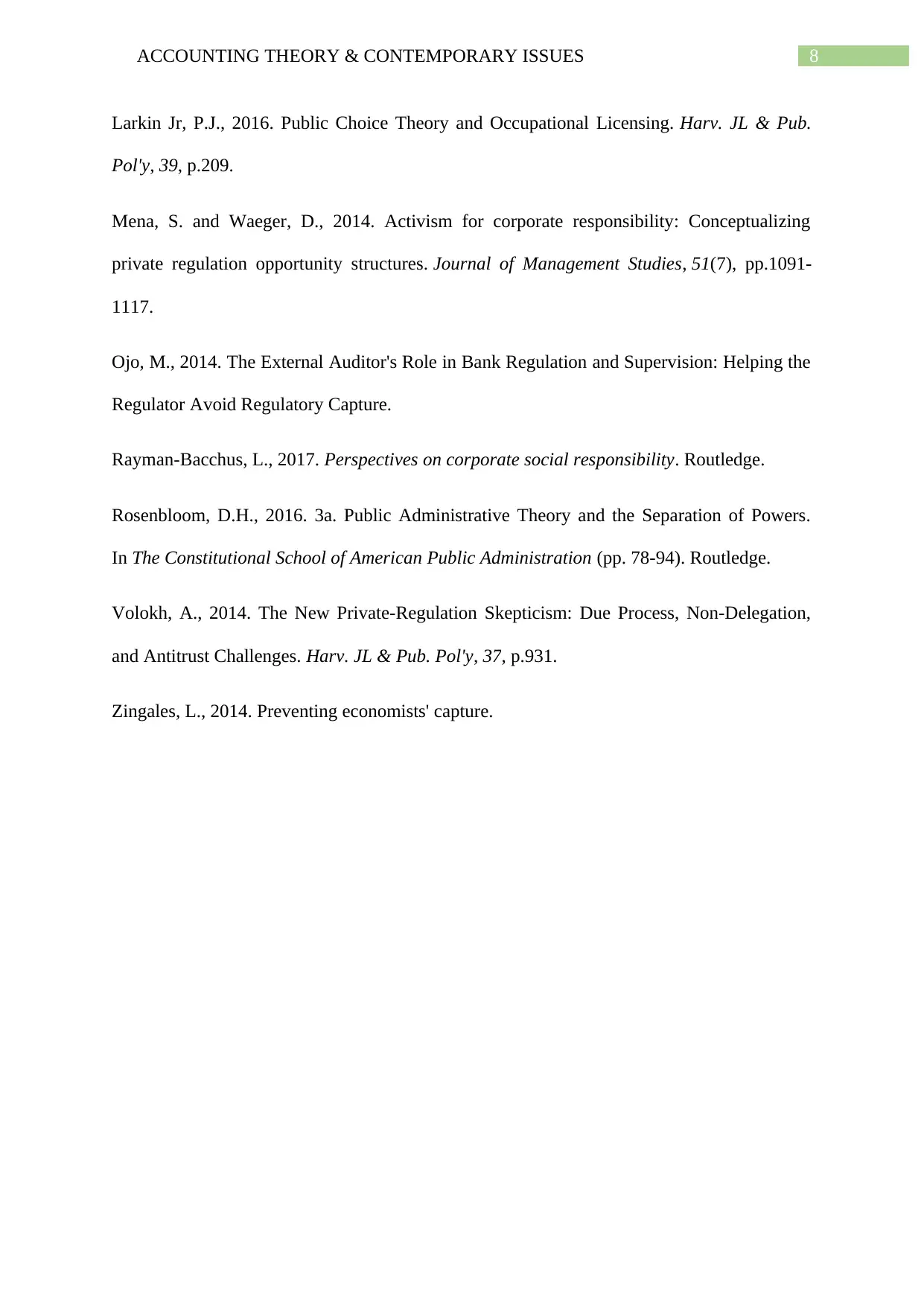
8ACCOUNTING THEORY & CONTEMPORARY ISSUES
Larkin Jr, P.J., 2016. Public Choice Theory and Occupational Licensing. Harv. JL & Pub.
Pol'y, 39, p.209.
Mena, S. and Waeger, D., 2014. Activism for corporate responsibility: Conceptualizing
private regulation opportunity structures. Journal of Management Studies, 51(7), pp.1091-
1117.
Ojo, M., 2014. The External Auditor's Role in Bank Regulation and Supervision: Helping the
Regulator Avoid Regulatory Capture.
Rayman-Bacchus, L., 2017. Perspectives on corporate social responsibility. Routledge.
Rosenbloom, D.H., 2016. 3a. Public Administrative Theory and the Separation of Powers.
In The Constitutional School of American Public Administration (pp. 78-94). Routledge.
Volokh, A., 2014. The New Private-Regulation Skepticism: Due Process, Non-Delegation,
and Antitrust Challenges. Harv. JL & Pub. Pol'y, 37, p.931.
Zingales, L., 2014. Preventing economists' capture.
Larkin Jr, P.J., 2016. Public Choice Theory and Occupational Licensing. Harv. JL & Pub.
Pol'y, 39, p.209.
Mena, S. and Waeger, D., 2014. Activism for corporate responsibility: Conceptualizing
private regulation opportunity structures. Journal of Management Studies, 51(7), pp.1091-
1117.
Ojo, M., 2014. The External Auditor's Role in Bank Regulation and Supervision: Helping the
Regulator Avoid Regulatory Capture.
Rayman-Bacchus, L., 2017. Perspectives on corporate social responsibility. Routledge.
Rosenbloom, D.H., 2016. 3a. Public Administrative Theory and the Separation of Powers.
In The Constitutional School of American Public Administration (pp. 78-94). Routledge.
Volokh, A., 2014. The New Private-Regulation Skepticism: Due Process, Non-Delegation,
and Antitrust Challenges. Harv. JL & Pub. Pol'y, 37, p.931.
Zingales, L., 2014. Preventing economists' capture.
⊘ This is a preview!⊘
Do you want full access?
Subscribe today to unlock all pages.

Trusted by 1+ million students worldwide
1 out of 9
Related Documents
Your All-in-One AI-Powered Toolkit for Academic Success.
+13062052269
info@desklib.com
Available 24*7 on WhatsApp / Email
![[object Object]](/_next/static/media/star-bottom.7253800d.svg)
Unlock your academic potential
Copyright © 2020–2025 A2Z Services. All Rights Reserved. Developed and managed by ZUCOL.





